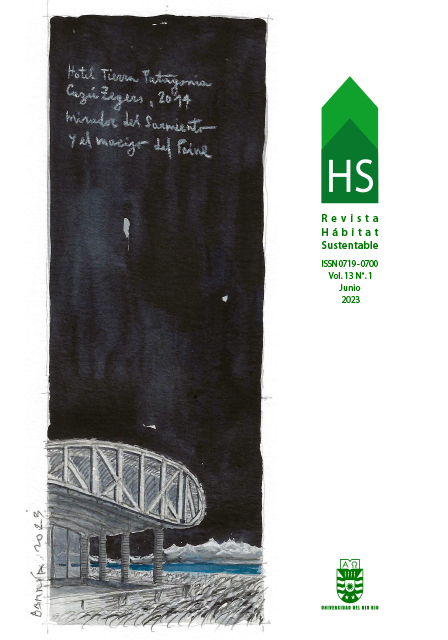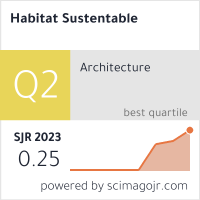Cambio climático y confort térmico en la vivienda de interés social colombiana
DOI:
https://doi.org/10.22320/07190700.2023.13.01.06Palabras clave:
cambio climático, viviendas de interés social, confort térmicoResumen
El cambio climático es una de las problemáticas más relevantes del siglo XXI a nivel mundial y, a pesar del desarrollo de estrategias que buscan minimizar sus consecuencias, es una realidad irreversible. Por consiguiente, es pertinente analizar su impacto sobre la arquitectura colombiana, específicamente en la Vivienda de Interés Social (VIS), tipo de edificación que más se construye en el país. El objetivo de esta investigación fue conocer el desempeño térmico de la VIS actual, en relación con el cambio climático, a partir de un modelo tipo para las ciudades más pobladas de Colombia Bogotá, Medellín y Cali. Dicho modelo se realizó a través de simulaciones computacionales en tres escenarios futuros (2030/2050/2080), los que permitieron diagnosticar cómo el cambio climático tendrá efecto en el confort térmico de sus ocupantes. Dentro de los resultados se demuestra que, del total de los escenarios evaluados (576), tan sólo el 18,9% se encuentra en un rango aceptable de tiempo en confort térmico (>70%). Esto que indica que la mayor parte de la VIS actualmente construida en Colombia no brinda condiciones de confort térmico tanto en un escenario de cambio climático como en el escenario actual, pues en ambas situaciones los casos favorables representan un bajo porcentaje respecto del total de los casos evaluados.
Descargas
Citas
ALABSI, A. A. N., WU, Y., KOKO, A. F., ALSHAREEM, K. M. & HAMED, R. (2021). Towards Climate Adaptation in Cities: Indicators of the Sustainable Climate adaptive Urban Fabric of Traditional Cities in West Asia. Applied Sciences, 11(21), 10428. DOI: https://doi.org/10.3390/app112110428
ALEKSIĆ, J., KOSANOVIĆ, S., TOMANOVIĆ, D., GRBIĆ, M., & MURGUL, V. (2016). Housing and Climate Change-related Disasters: A Study on Architectural Typology and Practice. Procedia Engineering, 165, 869–875. DOI: https://doi.org/10.1016/j.proeng.2016.11.786
ASHRAE 55 (2020). ANSI/ASHRAE Standard 55-2020: Thermal Environmental Conditions For Human Occupancy. Edit. ASHRAE Standar, American National Standards Institute (ANSI). GAJ0392, Recuperado de: www.ashrae.org
Asociación Brasilera de Normas Técnicas (ABNT). (2013). NBR 15575 - Desempenho de edifícios habitacionais de até cinco pavimentos - Parte 1.
Departamento Administrativo Nacional de Estadística. (2018). Censo nacional de población y vivienda 2018. Resultados Colombia total nacional. DANE. Recuperado de: https://www.dane.gov.co/files/censo2018/infografias/info-CNPC-2018total-nal-colombia.pdf
Departamento Administrativo Nacional de Estadística. (2021a). Censo de edificaciones (CEED) Históricos. DANE. Recuperado de: https://www.dane.gov.co/index.php/estadisticas-por-tema/construccion/censo-de-edificaciones/ceed-historicos
Departamento Administrativo Nacional de Estadística. (2021b). Informes de Estadística Sociodemográfica Aplicada: Patrones y tendencias de la transición urbana en Colombia (Nro.7). Gobierno de Colombia. Recuperado de:https://www.dane.gov.co/files/investigaciones/poblacion/informes-estadisticas-sociodemograficas/2021-10-28-patrones-tendencias-de-transicion-urbana-en-colombia.pdf
ECKARDT, F. (2011). Landscapes of Disaster. Topos, (76), 47–50. Recuperado de: https://www.uni-weimar.de/fileadmin/user/fak/architektur/professuren_institute/Stadtforschung/media/Landscapes_of_Disaster_Topos_F_Eckardt.pdf
ESCOTO CASTILLO, A., SÁNCHEZ PEÑA, L. & GACHUZ DALGADO, S. (2017). Trayectorias Socioeconómicas Compartidas (SSP): nuevas maneras de comprender el cambio climático y social. Estudios Demográficos y Urbanos, 32(3), 669–693. DOI: https://doi.org/10.24201/edu.v32i3.1684
GAMBLE, J., L., EBI, K., GRAMBSCH, A. E., SUSSMAN, F. G. & WILBANKS, T. J. (2009). Analyses of the Effects of Global Change on Human Health and Welfare and Human Systems (SAP 4.6) United States, Environmental Protection Agency, Washington, D.C.
GIFREU, J. (2018). Ciudades adaptativas y resilientes ante el cambio climático: estrategias locales para contribuir a la sostenibilidad urbana. Revista Aragonesa de Administración Pública, (52), 102-158. Recuperado de: https://dialnet.unirioja.es/servlet/articulo?codigo=6759308
GIRALDO, C., BEDOYA, C., & ALONSO, L. (2015). Eficiencia energética y sostenibilidad en la vivienda de interés social en Colombia. En Greencities & Sostenibilidad, 155–180. Málaga, España: Universidad Politécnica de Madrid. Recuperado de: https://oa.upm.es/42543/1/INVE_MEM_2015_229809.pdf
GIRALDO, W. & HERRERA, C. A. (2017). Ventilación pasiva y confort térmico en vivienda de interés social en clima ecuatorial. Ingeniería y Desarrollo, 35(1), 77–101. Recuperado de: http://www.scielo.org.co/pdf/inde/v35n1/2145-9371-inde-35-01-00077.pdf
GODOY MUÑOZ, A. (2012). El confort térmico adaptativo: aplicación en la edificación en España. [Tesis de Maestría, Universidad Politécnica de Cataluña]. Portal de acceso abierto al conocimiento de la UPC. Recuperado de: https://upcommons.upc.edu/bitstream/handle/2099.1/18763/TFM_Alfonso%20Godoy%20Munoz.pdf?sequence=1&isAllowed=y
IDEAM & UNAL. (2018). Variabilidad Climática y Cambio Climático en Colombia, Instituto de Hidrología, Meteorología y Estudios Ambientales., Universidad Nacional de Colombia. Recuperado de: http://documentacion.ideam.gov.co/openbiblio/bvirtual/023778/variabilidad.pdf
IPCC. (2007). Cambio climático 2007: Informe de síntesis. (Nro. 4). Informe público 2007. IPCC. Recuperado de: https://www.ipcc.ch/site/assets/uploads/2018/02/ar4_syr_sp.pdf
IPCC. (2020). El cambio climático y la tierra. Informe público 2020. IPCC. Recuperado de:
https://www.ipcc.ch/site/assets/uploads/sites/4/2020/06/SRCCL_SPM_es.pdf
ISO 7730 (2005). Ergonomics of the thermal environment — Analytical determination and interpretation of thermal comfort using calculation of the PMV and PPD indices and local thermal comfort criteria. Recuperada de: https://www.iso.org/cms/render/live/en/sites/isoorg/contents/data/standard/03/91/39155.html
JANUSZKIEWICZ, K. (2017). Climate Change Adopted Building Envelope as A Protector of Human Health in the Urban Environment. IOP Conference Series: Materials Science and Engineering, 245(5), 1-7. DOI: https://doi.org/10.1088/1757-899X/245/5/052004
KEBEDE, A. S., NICHOLLS, R. J., ALLAN, A., ARTO, I., CAZCARRO, I., FERNANDES, J. A, HILL, C. T., HUTTON, C. W., KAY, S., LÁZÁR, A. N., MACADAM, I., PALMER, M., SUCKALL, N., TOMPKINS, E. L., VINCENT, K. & WHITEHEAD, P. W. (2018). Applying the global RCP–SSP–SPA scenario framework at sub-national scale: A multi-scale and participatory scenario approach. Science of the Total Environment, 635, 659–672. DOI: https://doi.org/10.1016/j.scitotenv.2018.03.368
LENZUNI, P. (2021). Compliance with limits of acceptability for thermal comfort, and implications for long-term comfort. Building and Environment, 204, 108067. DOI: https://doi.org/10.1016/j.buildenv.2021.108067
Ministerio de Vivienda Ciudad y Territorio. (2020). VIS y VIP | Minvivienda. Ministerio de Vivienda, Ciudad y Territorio. Recuperado de: https://www.minvivienda.gov.co/viceministerio-de-vivienda/vis-y-vip
Murillo, M., Calle J., Jaramillo, S., Garavito, A. & Parra, E. (2022). Desempeño térmico de la vivienda social por niveles según el cambio climático. VI Congreso Internacional Medio Ambiente Construido y Desarrollo Sustentable (MACDES), La Habana, Cuba.
O’NEILL, B. C., KRIEGLER, E., RIAHI, K., EBI, K. L., HALLEGATTE, S., CARTER, T. R., MATHUR, R. & VAN VUUREN, D. P. (2014). A new scenario framework for climate change research: The concept of shared socioeconomic pathways. Climatic Change, 122, 387-400. DOI: https://doi.org/10.1007/s10584-013-0905-2
PABÓN, J. (2012). Cambio climático en Colombia: Tendencias en la segunda mitad del siglo XX y escenarios posibles para el siglo XXI. Revista de la Academia Colombiana de Ciencias Exactas, Físicas y Naturales, 36(139), 261-278. Recuperado de: http://www.scielo.org.co/scielo.php?script=sci_arttext&pid=S0370-39082012000200010&lng=en&nrm=iso&tlng=es
PABÓN, J. & MONTEALEGRE, E. (2017). Los fenómenos de El Niño y de La Niña, su efecto climático e impactos socioeconómicos. Revista de la Academia Colombiana de ciencias exactas, 41(34), 1-168. Recuperado de: https://repositorio.accefyn.org.co/handle/001/113
PEDERSEN, J. S. T., DUARTE SANTOS, F., VAN VUUREN, D., GUPTA, J., ENCARNAÇÃO COELHO, R., APARÍCIO, B. A. & SWART, R. (2021). An assessment of the performance of scenarios against historical global emissions for IPCC reports. Global Environmental Change, 66, 102199. DOI: https://doi.org/10.1016/j.gloenvcha.2020.102199
PEREIRA RUCHANSKY, L. (2019). Evaluación del desempeño térmico y energético de mejoras pasivas aplicadas a vivienda existente en contexto de cambio climático en Montevideo (Uruguay). [Tesis de Maestría, Universidad del Bío-Bío]. Repositorio digital-Sistema de bibliotecas Universidad del Bío-Bío. Recuperado de: http://repobib.ubiobio.cl/jspui/bitstream/123456789/3868/1/Pereira_Ruchansky_Lucia.pdf
PÉREZ-FARGALLO, A., PULIDO-ARCAS, J. A., RUBIO-BELLIDO, C., TREBILCOCK, M., PIDERIT, B. & ATTIA, S. (2018). Development of a new adaptive comfort model for low-income housing in the central-south of Chile. Energy and Buildings, 178, 94–106. DOI: https://doi.org/10.1016/j.enbuild.2018.08.030
QUANTE, M. & BJØRNÆS, C. (2016). Introduction to the Assessment—Characteristics of the Region. In: Quante, M., Colijn, F. (eds) North Sea Region Climate Change Assessment. Regional Climate Studies. Springer. DOI: https://doi.org/10.1007/978-3-319-39745-0_1
RUBIO-BELLIDO, C., PÉREZ-FARGALLO, A., PULIDO-ARCAS, J. & TREBILCOCK, M. (2017). Application of adaptive comfort behaviors in Chilean social housing standards under the influence of climate change. Building Simulation, 178(10), 933–947. DOI: https://doi.org/10.1007/s12273-017-0385-9
RUEDA LÓPEZ, M. J., MOUJALLED, B., GUYOT, G., GOLLY, B., ONDARTS, M., WURTZ, F. & GONZE, E. (2023). Analysis and comparison of thermal comfort indicators based on a long-term campaign in low energy residences. Journal of Building Engineering, 65, 105707. DOI: https://doi.org/10.1016/j.jobe.2022.105707
SOLEMMA L.L.C. (2020). Solemma. ClimateStudio Documents. Recuperado de: https://climatestudiodocs.com/docs/thermalAnalysis.html
SOTO-ESTRADA, E., ÁLVAREZ-CARRASCAL, M. F., GÓMEZ-LIZARAZO, J. & VALENCIA-MONTOYA, D. (2016). Confort térmico en Viviendas de Medellín. Revista Ingenierías Universidad de Medellín, 18(35), 51–68. DOI: https://doi.org/10.22395/RIUM.V18N35A4
UNE-EN 16798-1 (2020). Energy performance of buildings - Ventilation for buildings - Part 1: Indoor environmental input parameters for design and assessment of energy performance of buildings addressing indoor air quality, thermal environment, lighting and acoustics - Module M1-6. Recuperada de: https://www.une.org/encuentra-tu-norma/busca-tu-norma/norma?c=N0063261
Descargas
Publicado
Cómo citar
Número
Sección
Licencia
Derechos de autor 2023 Luisa Fernanda Callejas-Ochoa, Manuela Marín-Echeverri, Michel Steven Puerta-Sepúlveda, Valentina Arroyave-Molina, Monique Silva-Neves

Esta obra está bajo una licencia internacional Creative Commons Atribución-CompartirIgual 4.0.
El contenido de los artículos que se publican en cada número de Hábitat Sustentable, es responsabilidad exclusiva de los autores y no representan necesariamente el pensamiento ni comprometen la opinión de la Universidad del Bío-Bío.
Los autores/as conservarán sus derechos de autor y garantizarán a la revista el derecho de primera publicación de su obra, el cuál estará simultáneamente sujeto a la Licencia de Reconocimiento de Creative Commons CC BY-SA que permite a otros compartir-copiar, transformar o crear nuevo material a partir de esta obra con fines no comerciales, siempre y cuando se reconozcan la autoría y la primera publicación en esta revista, y sus nuevas creaciones estén bajo una licencia con los mismos términos.











 Programa de Información Científica/Concurso Fondos de Publicación de Revistas Científicas 2018/ Proyecto Mejoramiento de Visibilidad de Revistas UBB (Código:FP180007)
Programa de Información Científica/Concurso Fondos de Publicación de Revistas Científicas 2018/ Proyecto Mejoramiento de Visibilidad de Revistas UBB (Código:FP180007) 





